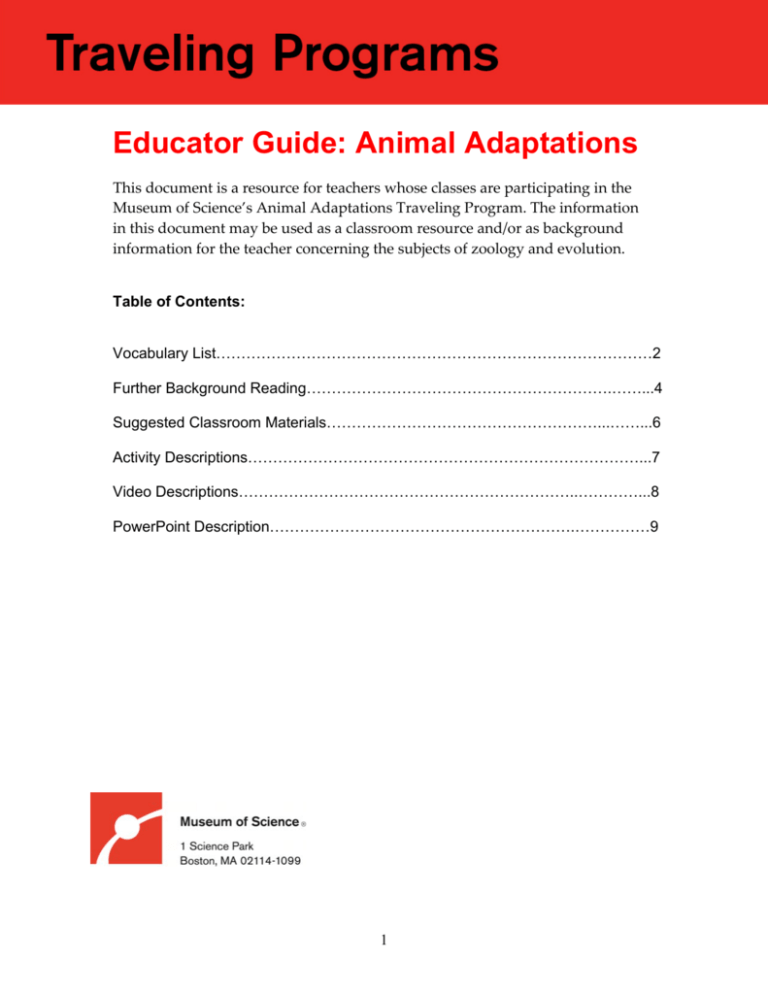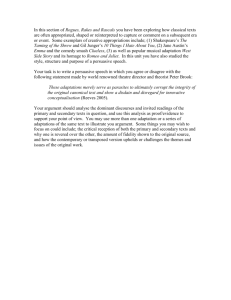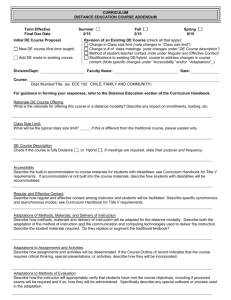Educator Guide: Animal Adaptations
advertisement

Educator Guide: Animal Adaptations This document is a resource for teachers whose classes are participating in the Museum of Science’s Animal Adaptations Traveling Program. The information in this document may be used as a classroom resource and/or as background information for the teacher concerning the subjects of zoology and evolution. Table of Contents: Vocabulary List……………………………………………………………………………2 Further Background Reading…………………………………………………….……...4 Suggested Classroom Materials………………………………………………...……...6 Activity Descriptions……………………………………………………………………...7 Video Descriptions…………………………………………………………..…………...8 PowerPoint Description…………………………………………………….……………9 1 Vocabulary List This is a list of common biology terms that teachers may wish to be familiar with for the Animal Adaptations program. This list is also a suggestion of vocabulary for students participating in the Animal Adaptations program to learn, though prior study of these words is not required for student participation. Adapt – to alter behavior or appearance based on the demands of the environment Adaptation – a trait or feature that helps a living being survive in their environment and have successful offspring. Adaptations are built into DNA, and are not “made up” during the life of an animal or plant. Amphibian – an ectothermic animal with a backbone that spends the first phase of its life in water, then goes through metamorphosis to alter its body, often altering it for life on land Behavioral Adaptation – an adaptation which involves an action of a living thing, rather than the physical capabilities of its body parts (ex: a bird builds a nest for its eggs) Biology – the study of living things Bird – an endothermic animal with a backbone that has feathers, breathes using lungs, and lays hard shell eggs Canine – a sharp tooth found towards the sides of a mammal’s jaw, often used for ripping and tearing into meat; not all mammals have this type of tooth Carnivore – an animal that primarily eats meat to get nutrition DNA – instructions written in cells for how to build the organism of which they are a part Ectothermic – cold‐blooded; requiring an external source of heat to heat one’s body 2 Endothermic – warm‐blooded; being able to heat oneself internally, using food as a fuel source Evolution – how living things change over time; the changes in the gene pool of a population from generation to generation by processes such as mutation and natural selection Feature – see “Trait” Fish – an animal that is obligated to live in the water, has a backbone, and uses gills to get oxygen Genes – specific pieces of DNA that give instructions for building specific parts of the body (ex: you may have a gene for having dark hair, while your friend has a gene for light hair) Herbivore – an animal that primarily eats plants to get nutrition (not a vegetarian, as a vegetarian is an omnivore who has made the life choice to only eat plants) Incisor – a flat tooth found in the front of the mouth of many mammals, used for chopping food Invertebrate – an animal that does not have a backbone Mammal – an endothermic animal that has fur or hair, has a backbone, produces milk, breathes using lungs, and usually has live birth Molar – a blocky tooth found in the back of the mouths of most mammals, used for smashing and grinding up food Mutation – a change in DNA Natural Selection – a method by which evolution works: creatures without the right adaptations for their environment will not survive or raise a family, whereas those whose adaptations better suit their environment will survive and raise a family; in other words, nature ‘selects’ which adaptations get passed on to future generations because creatures with unsuccessful adaptations die out. Omnivore – an animal that eats both plants and meat for nutrition 3 Physical Adaptation – an adaptation which involves the physical appearance and capabilities of a living thing, rather than the actions of the living thing (ex: a bird has wings for flight) Predator – an animal that hunts other animals for food Prey – an animal that is hunted by other animals Reptile – an ectothermic animal with a backbone that has scales, usually has soft shell egg development, and breathes using lungs Scavenger – an animal that eats animals that are already dead, thereby not needing to hunt them Trait – a particular part of an animal’s body or behavior that can be used to tell it apart from other animals (ex: feathered wings, hibernation, spotted fur) Vertebrate – an animal with a backbone 4 Further Background Reading This is a suggested reading list for teachers looking to improve their understanding of biology and zoology. Books Animal: the Definitive Visual Guide to the World’s Wildlife by David Burnie. DK Adult. 2005. Your Inner Fish by Neil Shubin. Pantheon Books. 2008. Animal Life: Secrets of the Animal World Revealed by DK Publishing. DK Adult. 2008. Links Animal Diversity Web (detailed information about particular animal species) – http://animaldiversity.ummz.umich.edu/site/index.html National Geographic’s Animal Facts pages – http://animals.nationalgeographic.com/animals/facts/ ARKive (images and facts about endangered species around the world) – http://www.arkive.org/ Berkeley’s guide to teaching evolution – http://evolution.berkeley.edu/ 5 Classroom Materials Below are some suggestions for books, videos, and websites to help students increase their understanding of biology and zoology. Books Life on Earth: The Story of Evolution by Steve Jenkins. Houghton Mifflin Books for Children. 2002. National Geographic Encyclopedia of Animals by Karen McGhee and George McKay, PhD. National Geographic Children’s Books. 2006. Ecology (DK Eyewitness Books) by Brian Lane and Steve Pollock. DK Children. 2005. Evolution (DK Eyewitness Books) by Linda Gamlin. DK Children. 2009. Videos Life of Birds. BBC Warner. 1998. Life of Mammals. BBC Warner. 2003. Life in the Undergrowth. BBC Warner. 2006. Life in Cold Blood. BBC Warner. 2008. Links BioKids (informational website about a large variety of animal species) – http://www.biokids.umich.edu/ National Geographic’s Animal Facts pages – http://animals.nationalgeographic.com/animals/facts/ Zoology for kids on the American Museum of Natural History’s “Ology” website – http://www.amnh.org/ology/index.php?channel=zoology 6 Activity Descriptions See the “Documents” section on the website to download these activities. Adapting Lizards In this activity, students will get a chance to adapt a species of lizard to its environment. Working in groups, each will take a lizard drawing packet to different island stations. Each island station has a different type of habitat, and the group assigned to the particular island will need to work together to decide what sort of adaptations their lizard species will need to survive. Students are encouraged to explore adaptations like color of the scales, size of the claws, and diet. As the teacher leads the class through several generations of lizards, students will see how their species has evolved for their island. Groups can then come back together and share the characteristics of their island, and what adaptations their lizard species evolved to deal with them. Students will be surprised at how different each group’s lizard turns out to be! Animal Detectives Students are challenged to observe a living animal – it could be a pet, wildlife in the park, or even a human – and find three interesting and/or odd things about how it looks or acts. As “Animal Detectives”, they must then piece together clues using their observational skills and what they have learned about animal adaptations to figure out why those animals look or behave the way they do. A worksheet is provided to help students solve these adaptation mysteries. 7 Video Descriptions See the “Media” section on the website to download these videos. Snapping Turtle Snaps! This six second clip shows off just how fast the snap of a snapping turtle can be. It is a clear demonstration of this amazing adaptation, and is always a student favorite! How a Snake Eats This eight second clip demonstrates how a snake uses its split lower jaw to “walk” its food down its throat. The clip is perfect for reviewing the fact that snakes do not dislocate their jaws to eat, as popular culture lends us to believe, and just have instead a different jaw structure altogether which allows for this useful adaptation to take place. 8 PowerPoint Description See the “Documents” section of the website to download the PDF of this PowerPoint. Animal Fact Slides This PowerPoint PDF contains the “fact slides” that students may have seen during the Animal Adaptations program. These slides provide a chance for teachers to review what was learned with their students, and are recommended for use after the program has finished. Please note that this PDF may not contain all the species brought to the school, as the animals at the Live Animal Center at the Museum of Science are often in flux. This PDF is NOT meant to be a list of animals teachers may choose from to attend their program, as that decision, by museum policy, is up to the educator and the staff at the Live Animal Center. 9







